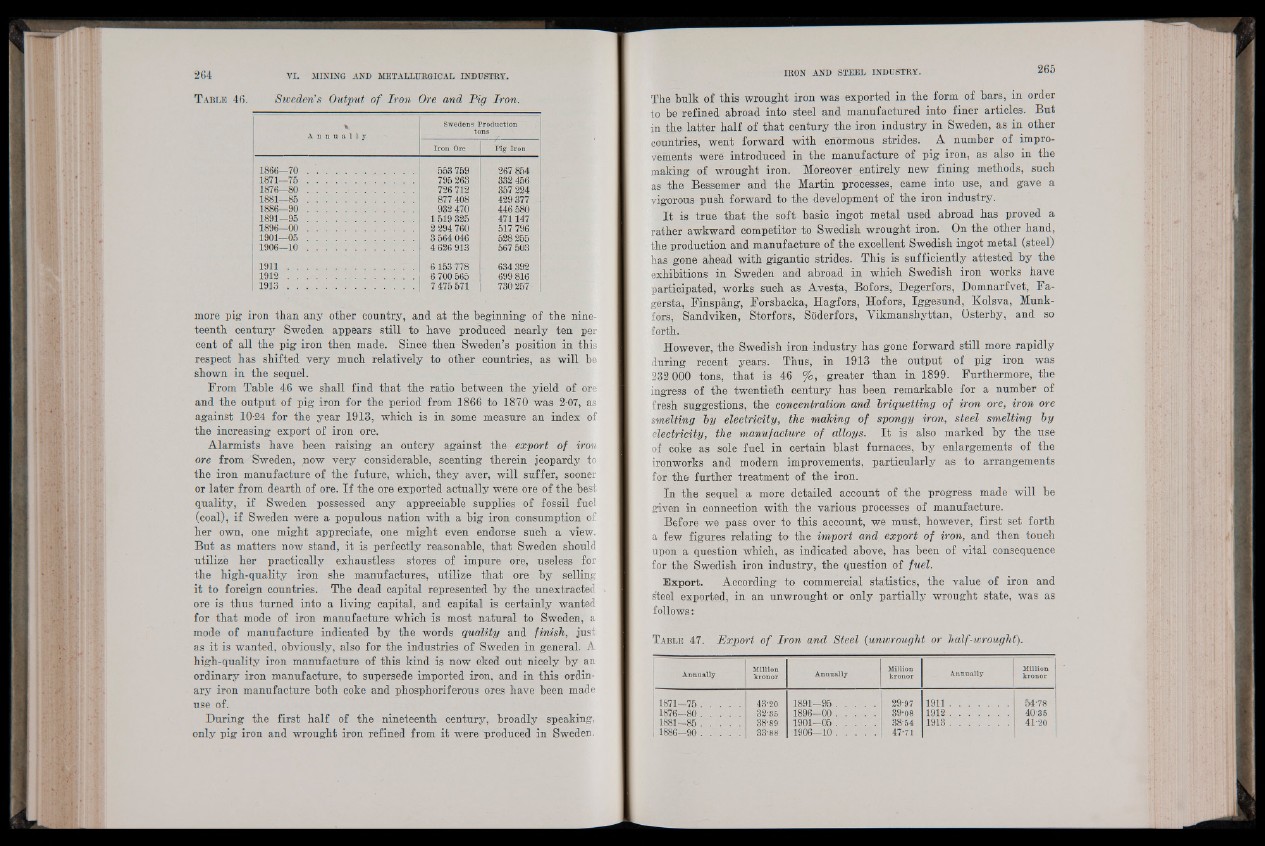
T able 46. Sweden's Output of Iron Ore and Pig Iron.
X
A n n u a l l y
Swedens ;
tc
Iron Ore
Production
ns
Pig Iron
1866—70 ............................................ 553 759 267 854
1871—75 ............................................ 795 263 332 456
1876—80 ............................................ 726 712 357 224
1881—85 ............................................ 877 408 429 377
1886—90 ........................................... 932 470 446 580
1891—95 ........................................... 1519325 471147
1896—00 ........................................... 2 294 760 517 796
1901—05 ............................................ 3 564 046 528 255
1906-10 ............................................ 4 626 913 567 503
1 9 1 1 .................................................... 6 153 778 634 392
1 9 1 2 .................................................... 6 700 565 699 816
1 9 1 3 .................................................... 7 475 571 730 257
more pig iron than any other country, and at the beginning of the nineteenth
century Sweden appears still to have produced nearly ten per
cent of all the pig iron then made. Since then Sweden’s position in this
respect has shifted very much relatively to other countries, as will he
shown in the sequel.
From Table 46 we shall find that the ratio between the yield of ore
and the output of pig iron for the period from 1866 to 1870 was 2-07, as
against 10-24 for the year 1913, which is in some measure an index of
the increasing export of iron ore.
Alarmists have been raising an outcry against the export of iron
ore from Sweden, now very considerable, scenting therein jeopardy to
the iron manufacture of the future, which, they aver, will suffer, sooner
or later from dearth of ore. I f the ore exported actually were ore of the best
quality, if Sweden possessed any appreciable supplies of fossil fuel
(coal), if Sweden were a populous nation with a big iron consumption of
her own, one might appreciate, one might even endorse such a view.
But as matters now stand, it is perfectly reasonable, that Sweden should
utilize her practically exhaustless stores of impure ore, useless for
the high-quality iron she manufactures, utilize that ore by selling
it to foreign countries. The dead capital represented by the unextracted
ore is thus turned into a living capital, and capital is certainly wanted
for that mode of iron manufacture which is most natural to Sweden, a
mode of manufacture indicated by the words quality and finish, just
as it is wanted, obviously, also for the industries of Sweden in general. A
high-quality iron manufacture of this kind is now eked out nicely by an
ordinary iron manufacture, to supersede imported iron, and in this ordinary
iron manufacture both coke and phosphoriferous ores have been made
use of.
During the first half of the nineteenth century, broadly speaking,
only pig iron and wrought iron refined from it were produced in Sweden.
The bulk of this wrought iron was exported in the form of bars, in order
to be refined abroad into steel and manufactured into finer articles. But
in the latter half of that century the iron industry in Sweden, as in other
countries, went forward with enormous strides. A number of improvements
were introduced in the manufacture of pig iron, as also in the
making- of wrought iron. Moreover entirely new fining methods, such
as the Bessemer and the Martin processes, came into use, and gave a
vigorous push forward to the development of the iron industry.
It is true that the soft basic ingot metal used abroad has proved a
rather awkward competitor to Swedish wrought iron. On the other hand,
the production and manufacture of the excellent Swedish ingot metal (steel)
has gone ahead with gigantic strides. This is sufficiently attested by the
exhibitions in Sweden and abroad in which Swedish iron works have
participated, works such as Avesta, Bofors, Degerfors, Domnarfvet, Fa-
gersta, Finspang, Forsbacka, Hagfors, Hofors, Iggesund, Kolsva, Munk-
fors, Sandviken, Storfors, Soderfors, Vikmanshyttan, Osterby, and so
forth.
However, the Swedish iron industry has gone forward still more rapidly
during recent, years. Thus, in 1913 the output of pig iron was
232 000 tons, that is 46 %, greater than in 1899. Furthermore, the
ingress of the twentieth century has been remarkable for a number of
fresh suggestions, the concentration and briquetting of iron ore, iron ore
smelting by electricity, the making of spongy iron, steel smelting by
electricity, the manufacture of alloys. It is also marked by the use
of coke as sole fuel in certain blast furnaces, by enlargements of the
ironworks and modern improvements, particularly as to arrangements
for the further treatment of the iron.
In the sequel a more detailed account of the progress made will be
given in connection with the various processes of manufacture.
Before we pass over to this account, we must, however, first set forth
a few figures relating to the import and export of iron, and then touch
upon a question which, as indicated above, has been of vital consequence
for the Swedish iron industry, the question of fuel.
Export. According to commercial statistics, the value of iron and
steel exported, in an unwrought or only partially wrought state, was as
follows:
T a b le 47. Export of Iron and Steel (unwrought or half-wrought).
Annually
kronor Annually Million
Million
kronor Annually Million
kronor
1871-75 ................ 43-20 1891—95 ................ 29-97 1911........................ 54-78
1876—80 . . . . . 32-35 1896—00 ................ 39-08 1912 . . . . . . . 40-35
1881—85 ................ 38-89 1901—05 ................ 38-54 1913........................ 41-20
1886-90 ................ 33-88 1906—10 ................ 47-71